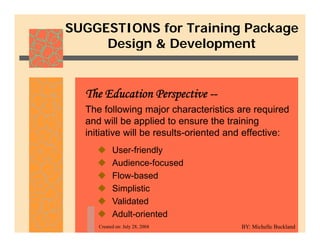
Instructional Design and Development Tips.pdf
- 1. SUGGESTIONS for Training Package Design & Development Design & Development The following major characteristics are required The Education Perspective -- The following major characteristics are required and will be applied to ensure the training initiative will be results-oriented and effective: ‹ User-friendly ‹ Audience-focused ‹ Flow-based ‹ Simplistic ‹ Validated Created on: July 28, 2004 ‹ Validated ‹ Adult-oriented BY: Michelle Buckland
- 2. User-Friendly Content (i.e. according to audiences level of k l d / kill) knowledge/skill) ‹ Knowledge - The learners to have the ability to GOAL: remember material previously. ‹ Comprehension – The learners to have the ability to grasp the meaning of the material. y g p g ‹ Application – The learners to have the ability to use learned material in new, concrete situations situations. ‹ Analysis – The ability to break down material into its components so that its organizational t t b d t d BY: Michelle Buckland Created on: July 28, 2004 structure can be understood.
- 3. Flow-based GOAL: ‹ The content is to be consistent with the agenda (i.e. a thorough structure). BY: Michelle Buckland Created on: July 28, 2004
- 4. Simplistic ‹ The content/images are meant to GOAL: ‹ The content/images are meant to support your verbal presentation, not take its place. ‹ Select only key words and phrases; therefore use no more than 6 words therefore, use no more than 6 words per line, 6 lines per image, and can be seen from 6 feet away. BY: Michelle Buckland Created on: July 28, 2004
- 5. Validation … ‹ GOAL: ‹ Course Development Process 1. Determine skills needed. 2 Establish overall purpose of the course 2. Establish overall purpose of the course (based on the skills needed). 3. Write the learning objectives (SMART – S ifi M bl A hi bl R lt Specific; Measurable; Achievable; Results- based; Timebound). 4. Match the content to the learning BY: Michelle Buckland Created on: July 28, 2004 objectives.
- 6. Validation (cont’d) … ‹ Synthesize The learners to have the ability to GOAL: ‹ Synthesize – The learners to have the ability to put parts together to form a new whole; or in other words, put the context together to form a d l module. ‹ Evaluate – The learners to have the ability to judge the value of the material for the given purpose. BY: Michelle Buckland Created on: July 28, 2004
- 7. Adult-oriented Adult oriented Teaching by Demonstration > “Hands-on” Skills as the Expected Outcome GOAL: the Expected Outcome 1. Describe the desired outcome. 2. Stimulate a recall of relevant prerequisites. 3. Identify the steps. 4. Personalize the demonstration. 5. Devise opportunities for practice (e.g. activities, exercises, etc.). 6. Make transfer of learning possible → real-life application. BY: Michelle Buckland Created on: July 28, 2004 7. Appraise performance (e.g. tests, etc.). 8. Ensure retention.
- 8. Adult-oriented … Adult oriented … GOAL: Flexing Learning Styles > Helps to identify Flexing Learning Styles > Helps to identify a learner’s preference for certain learning behavior 1. Converger – A learner that develops theories, makes generalizations, theories and/or draws conclusions theories, and/or draws conclusions. • Relatively unemotional • Prefer to work with things rather than BY: Michelle Buckland Created on: July 28, 2004 g people
- 9. Adult-oriented … Adult oriented … Flexing Learning Styles (cont’d) 2. Diverger – A learner that prefers to participate in an experience. • Performs well in brainstorming Performs well in brainstorming sessions • Interested in people • Has the ability to view complex • Has the ability to view complex situations from many perspectives BY: Michelle Buckland Created on: July 28, 2004
- 10. Adult-oriented … Adult oriented … Flexing Learning Styles (cont’d) 3. Assimilator – A learner that makes sense of the experience (i.e. reflective observation). • Consider it important for the theory to be • Consider it important for the theory to be logically sound • Excel in the creation of the theoretical d l models BY: Michelle Buckland Created on: July 28, 2004
- 11. Adult-oriented … Adult oriented … Flexing Learning Styles (cont’d) 4. Accommodator – A learner that implements new action / experiments with new ways. • Strength lies in doing things and getting • Strength lies in doing things and getting fully involved in new experiences • Excels in situations calling for theory li ti t ifi i t application to specific circumstances • Problems are approached in an intuitive, trial-and-error manner BY: Michelle Buckland Created on: July 28, 2004
- 12. Adult-oriented … Adult oriented … Inspiring Participation > Regulate the GOAL: Inspiring Participation > Regulate the flow of all participants 1. Elicit and clarify the specific goals of the individuals as well as the more general purposes of the learning activities (i.e. group-based) group based). BY: Michelle Buckland Created on: July 28, 2004
- 13. Adult-oriented … Adult oriented … Inspiring Participation (cont’d) 2. Ensure all learning activities are useful and vary for all learners to participate (e g problem-centered vs subject- (e.g. problem centered vs. subject oriented, immediate application, building on previous experience, etc.). BY: Michelle Buckland Created on: July 28, 2004
